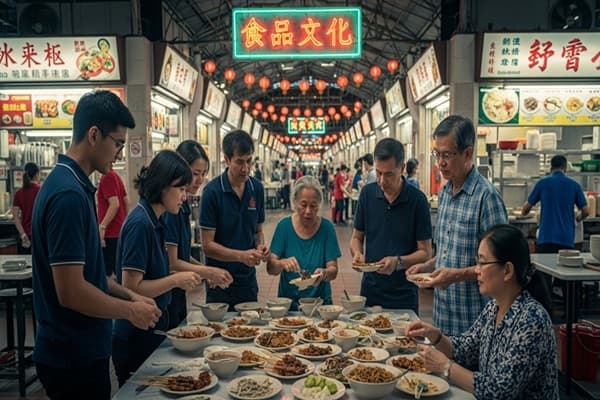
When you think of Chinatown hawker centers—especially in food capitals like Singapore, Kuala Lumpur, and Bangkok—you probably picture sizzling woks, fragrant noodle bowls, and the comforting chaos of lunchtime crowds. But tucked behind the steam and spices is something unexpected: a quiet, powerful movement that’s redefining how we think about food, waste, and community.
Let’s talk about Chinatown hawker leftovers—and why more people are seeing these end-of-day eats not as scraps, but as smart, sustainable gold.
A Cultural Tradition: The Heart of Chinatown’s Leftovers
In many Asian households, wasting food is more than frowned upon—it’s considered deeply disrespectful. Chinese culture, in particular, embraces frugality as a virtue. This value stretches back generations and is very much alive in modern Chinatowns.
Leftovers aren’t just “what’s left.” They’re part of daily life. Whether it’s packing up what you didn’t finish or transforming extra ingredients into new dishes, it’s about honoring food, the cook, and the earth.
At hawker stalls, this looks like:
-
Discounting unsold items before closing
-
Repurposing extra ingredients into the next day’s dishes
-
Offering combo meals from remaining portions
It’s practical. It’s cultural. And now, it’s becoming essential.
Hawker Centers: A Hidden Source of Urban Food Waste
While hawker centers are known for their incredible affordability and variety, they’re also surprising contributors to food waste—especially in urban hubs like Singapore.
According to Singapore’s National Environment Agency, about 20% of the city’s food waste comes from hawker centers. That’s a big number—and it’s mostly from:
-
Over-preparation to meet potential demand
-
Big portion sizes (which often go unfinished)
-
Competition pushing vendors to cook more than they need
-
Customers not finishing their meals
Here’s where leftovers consumption steps in—not just as a solution, but as a smarter way forward.
Food Waste and the Environment: What’s at Stake?
You may not see it on your plate, but wasted food takes a heavy toll on the planet. Globally, food waste is responsible for nearly 10% of greenhouse gas emissions—thanks to methane released from decomposing food in landfills.
Chinatowns, often densely packed and community-driven, are uniquely positioned to make a real impact. Just a few benefits of encouraging leftovers consumption:
-
Less food entering landfills
-
Reduced energy needed for waste disposal
-
Conservation of water, fuel, and labor in food production
-
Boosts grassroots climate efforts
In short: sustainability starts with what we don’t throw away.
The Economics of Leftovers: A Win-Win for All
For Vendors:
Leftovers aren’t losses—they’re opportunities. Instead of throwing out perfectly good food, hawkers are:
-
Offering discounted meals in the final hour of service
-
Creating special “leftover boxes” for budget diners
-
Saving food to use or sell the next day (safely stored, of course)
-
Partnering with real-time food apps to list unsold items
These steps not only cut losses but can also build customer loyalty.
For Customers:
If you’re on a budget—or just enjoy a good deal—this is great news. Diners benefit from:
-
Affordable, filling meals
-
Reduced food insecurity, especially for students and low-income patrons
-
A chance to support local hawkers while spending less
Everyone wins, and nothing goes to waste.
Spotlight: Singapore’s Chinatown Complex Food Centre
With over 260 stalls, the Chinatown Complex Food Centre in Singapore is a shining example of how this movement is evolving. Here’s what’s working:
-
Discount signs at stalls announcing last-hour specials
-
Zero Waste Singapore campaigns encouraging mindful eating
-
Food rescue volunteers redistributing leftovers to those in need
-
Apps like OLIO and Treatsure connecting hawkers to eco-minded diners
These initiatives don’t just reduce waste—they build a sense of community and mutual respect.
But Is It Safe? Addressing Health Concerns
Understandably, one of the biggest hesitations around eating leftovers is safety. The good news? Most Chinatown hawker centers operate under strict health codes.
Here’s how safety is managed:
-
Food is stored at regulated temperatures
-
Time limits are placed on how long food can sit before sale
-
Labels often indicate whether food is fresh or reheated
-
Regular inspections keep vendors accountable
When handled responsibly, leftover food can be just as safe—and just as delicious—as anything else on the menu.
Also Read : Aiden Langston Utah: A Life of Passion, Purpose, and Legacy
Fighting the Stigma: Changing the Conversation
Let’s face it—there’s still some social stigma around eating leftovers, especially when it’s associated with financial hardship. But that’s starting to change.
To shift the narrative, we need to:
-
Frame leftovers as an eco-conscious choice, not a desperate one
-
Use influencers, celebrities, and community leaders to normalize the practice
-
Include this topic in schools and youth programs
-
Introduce incentives and loyalty rewards for consumers and vendors alike
Being “green” is trendy—let’s make sustainable eating part of that trend.
Tech to the Rescue: How Innovation is Powering the Movement
In today’s digital world, tech is making it easier than ever to access—and benefit from—hawker leftovers.
Some of the standout tools:
-
OLIO, Treatsure, Yindii – apps listing real-time leftover deals
-
QR-based systems – let customers rate and give feedback on leftover meals
-
AI inventory tools – help hawkers plan better based on demand
-
Blockchain tracking – ensures transparency in leftover redistribution
These tools create transparency, convenience, and trust across the board.
Community & Non-Profit Power
Chinatown’s leftover movement wouldn’t be possible without passionate community players. Across the globe, you’ll find:
-
Student groups running “food rescue” projects
-
Elderly volunteers delivering uneaten meals to the needy
-
Religious organizations redistributing event leftovers
From San Francisco to Sydney’s Haymarket, these groups prove that food is more than nourishment—it’s a vehicle for kindness and connection.
How Governments Can Lend a Hand
For this trend to scale, policy support is crucial. Governments can:
-
Give tax breaks to hawkers donating food
-
Require clear labeling for reheated items
-
Fund community fridges or food banks near hawker centers
-
Support public-private tech collaborations for waste management
When policies support sustainability, entire cities thrive—not just individual vendors or consumers.
A Global Movement with Chinatown at the Center
Chinatowns have always been places where tradition meets adaptation. Their strong vendor networks, tight-knit communities, and deep respect for food make them natural leaders in this space.
Across the globe:
-
Japan’s food basements offer end-of-day discounts
-
Taiwan’s night markets embrace no-waste culture
-
Western cities are catching on, inspired by Chinatown models
This isn’t just an Asian practice—it’s a global solution in the making.
Final Thoughts: More Than Just Leftovers
At its core, the Chinatown hawker leftovers movement isn’t just about saving food. It’s about rethinking value—of food, of community, of culture.
So next time you’re at a hawker center and see a discounted dish near closing time, don’t think of it as a leftover. Think of it as your small but meaningful contribution to a smarter, more sustainable world.
FAQs: Quick Answers You Might Be Wondering
Q: Is it safe to eat leftover food from hawker centers?
A: Yes—when properly stored and handled. Most centers follow health guidelines to ensure food safety.
Q: How can I find leftover deals at Chinatown hawkers?
A: Check apps like OLIO or Treatsure, or simply visit near closing time and look for signs or ask vendors directly.
Q: Why does leftover consumption matter for sustainability?
A: It cuts food waste, reduces carbon emissions, and conserves resources like water and fuel.
Q: Are there government policies supporting this?
A: Yes. Singapore’s Zero Waste Masterplan, for instance, encourages businesses and consumers to embrace leftover food solutions.


